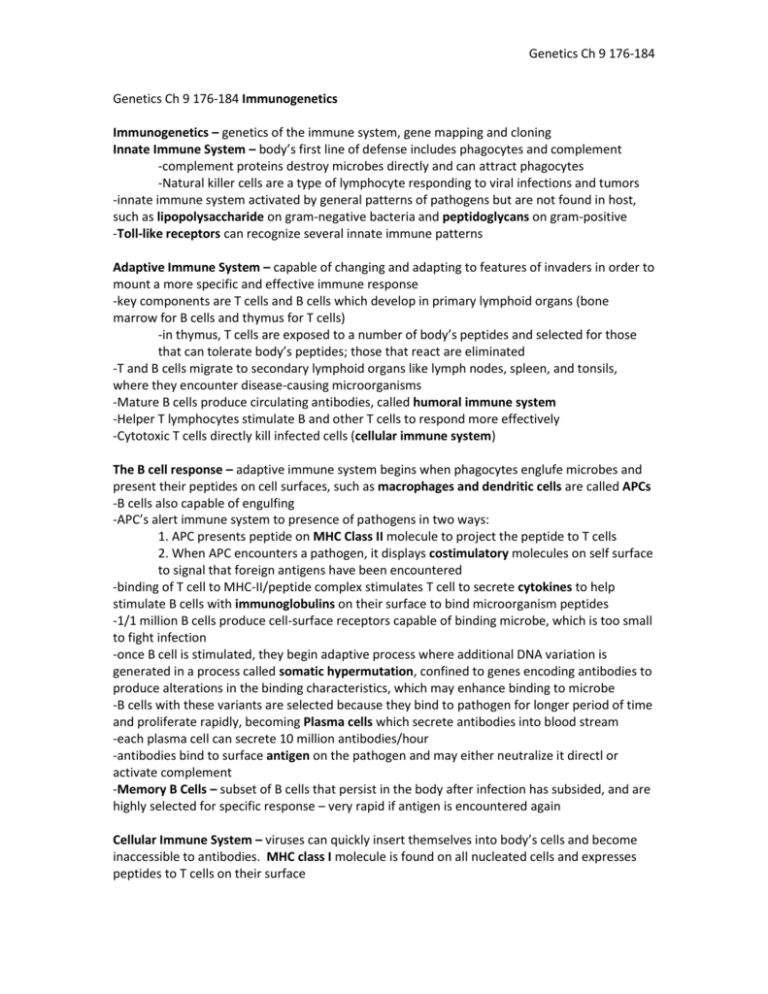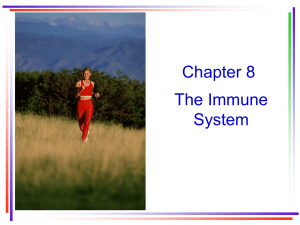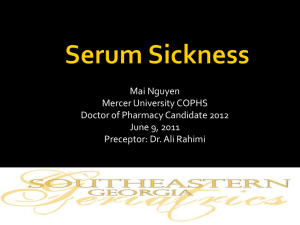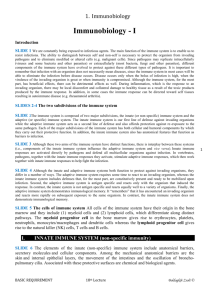Genetics Ch 9 176-184 [4-20
advertisement

Genetics Ch 9 176-184 Genetics Ch 9 176-184 Immunogenetics Immunogenetics – genetics of the immune system, gene mapping and cloning Innate Immune System – body’s first line of defense includes phagocytes and complement -complement proteins destroy microbes directly and can attract phagocytes -Natural killer cells are a type of lymphocyte responding to viral infections and tumors -innate immune system activated by general patterns of pathogens but are not found in host, such as lipopolysaccharide on gram-negative bacteria and peptidoglycans on gram-positive -Toll-like receptors can recognize several innate immune patterns Adaptive Immune System – capable of changing and adapting to features of invaders in order to mount a more specific and effective immune response -key components are T cells and B cells which develop in primary lymphoid organs (bone marrow for B cells and thymus for T cells) -in thymus, T cells are exposed to a number of body’s peptides and selected for those that can tolerate body’s peptides; those that react are eliminated -T and B cells migrate to secondary lymphoid organs like lymph nodes, spleen, and tonsils, where they encounter disease-causing microorganisms -Mature B cells produce circulating antibodies, called humoral immune system -Helper T lymphocytes stimulate B and other T cells to respond more effectively -Cytotoxic T cells directly kill infected cells (cellular immune system) The B cell response – adaptive immune system begins when phagocytes englufe microbes and present their peptides on cell surfaces, such as macrophages and dendritic cells are called APCs -B cells also capable of engulfing -APC’s alert immune system to presence of pathogens in two ways: 1. APC presents peptide on MHC Class II molecule to project the peptide to T cells 2. When APC encounters a pathogen, it displays costimulatory molecules on self surface to signal that foreign antigens have been encountered -binding of T cell to MHC-II/peptide complex stimulates T cell to secrete cytokines to help stimulate B cells with immunoglobulins on their surface to bind microorganism peptides -1/1 million B cells produce cell-surface receptors capable of binding microbe, which is too small to fight infection -once B cell is stimulated, they begin adaptive process where additional DNA variation is generated in a process called somatic hypermutation, confined to genes encoding antibodies to produce alterations in the binding characteristics, which may enhance binding to microbe -B cells with these variants are selected because they bind to pathogen for longer period of time and proliferate rapidly, becoming Plasma cells which secrete antibodies into blood stream -each plasma cell can secrete 10 million antibodies/hour -antibodies bind to surface antigen on the pathogen and may either neutralize it directl or activate complement -Memory B Cells – subset of B cells that persist in the body after infection has subsided, and are highly selected for specific response – very rapid if antigen is encountered again Cellular Immune System – viruses can quickly insert themselves into body’s cells and become inaccessible to antibodies. MHC class I molecule is found on all nucleated cells and expresses peptides to T cells on their surface Genetics Ch 9 176-184 -in an infected cell, MHC-I would express viral antigens on the cell’s surface, which alert T cells that can recognize the foreign peptides -MHC peptide binds T cell receptor which prompts T cell to emit chemicals to destroy infected cells (cytotoxic T cells) -T cells alerted to infection when circulating dendritic cells presenting the foreign antigen migrate to secondary lymphoid organs where the T cells reside -Th1 cells secrete cytokines like IL-2, IFN-g, and TNF to stimulate cytotoxic T cells to attack -Th2 cells secrete IL-4 and IL-5 to stimulate B cells whose receptors can bind foreign antigen -humoral immune system specialized against extracellular infections, while cellular immune system combats intracellular infections Immune Response Proteins: Genetic Basis of Diversity – each antibody is composed of 4 chains, 2 heavy chains and two light chains linked by disulfide bonds -the five heavy chains determine major class of antibody (isotype): γ, μ, α, δ, ε for IgG, IgM, IgA, IgD, and IgE respectively -the two light chains are κ and λ -immature B cells produce ONLY IgM but upon maturation they undergo Class (isotype) switching to produce the other 4 major classes which are localized in different body parts -The heavy and light chains contain both a constant and a variable region located at the carboxy and amino ends of the chains respectively -arrangement of genes encoding the constant region determines the isotype of the antibody -the variable region is responsible for antigen recognition and binding -three gene segments encode LIGHT chains: C for constant region, V for variable region, and J for region that joins the constant and variable region -FOUR genes encode the heavy chains, with C, V, and J coding for constant, variable and joining regions, and a Diversity (D) region located between joining and variable regions Genetic Basis of Antibody Diversity – immune system can generate 10 billion structurally diverse antibodies through several mechanisms 1. Multiple Germline Immunoglobulin Genes – each heavy and light chain has 80 different V segments located contiguously on germline, 6 J segments, and 30 D segments 2. Somatic Recombination (VDJ Recombination) – as antibodies are formed during B cell maturation, a specific combination of single V and J segments is selected for light chain, and another combination of V, D, and J segments selected for heavy chain by deleting DNA sequences separating the single V, J, and D segments before they are transcribed into mRNA a. Happens with Recombinases (RAG1 and 2), which initiate double-strand breaks at specific DNA sequences that flank the V and D gene segments b. After deletion of all but one V, D, and J segments, the nondeleted segments are joined together by ligases (somatic recombination) c. Mature B cells VARY in terms of rearranged antibody sequences, which can produce 100,000-1,000,000 different antibody molecules 3. Junctional Diversity – slight variations can occur where VDJ regions are joined, and small numbers of nucleotides can be added or deleted to create more variation 4. Somatic Hypermutation – normally only a small subset of B cells have antibodies on their surface which can bind antigen, and binding affinity is low. Once B cells are stimulated, they undergo affinity maturation characterized by somatic hypermutation Genetics Ch 9 176-184 of the V segments of antibody genes, caused by an enzyme activation-induced deaminase, which causes bases to be replaced by uracil a. Error prone polymerases are recruited to allow the bases to persist and allow the mutations to survive, this causes much additional variation immunoglobulin genes, especially because mutation is a random process b. B cells are selected for mutants with high affinity for antigen and are allowed to proliferate 5. Multiple Combinations of Heavy and Light Chains – random combination of different heavy/light chains assembling the immunoglobulin molecule -with all the mechanisms together, you can make 10^10 to 10^14 different antibodies T cell Receptors – T cell receptors are similar to antibody receptors and must be able ot bind a large amount of antigens, but T cell receptors are never secreted from the cell, and T cell activation requires presentation of foreign peptide on MHC molecule -90% of T cell receptors are heterodimers composed of α and β chains and 10% are composed of γ and δ chains -many of the mechanisms involved in generating antibody diversity, such as multiple germline segments, VDJ recombination, junctional diversity, are also important for T cell diversity, but SOMATIC HYPERMUTATION DOES NOT OCCUR because it helps to avoid generation of T cells reacting against body’s own cells


![Immune Sys Quiz[1] - kyoussef-mci](http://s3.studylib.net/store/data/006621981_1-02033c62cab9330a6e1312a8f53a74c4-300x300.png)





